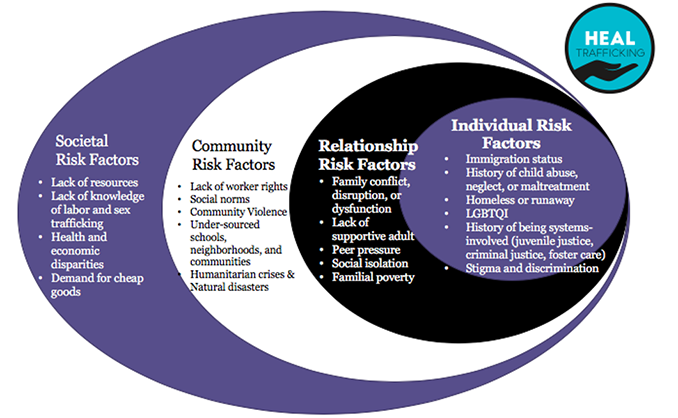Global Health & Health Equity: Assisting Clinicians in Addressing Human Trafficking
Written by Amy Sharpe, Sharp HealthCare, and Founder and Cochair, Health Subcommittee, San Diego Human Trafficking & Commercial Sexual Exploitation of Children (CSEC) Advisory Council, San Diego, CA; edited by Tony Nguyen, AHIP
Health care providers have unique opportunities to identify and support patients who have been trafficked for labor or sex. Because human trafficking happens in all communities and impacts the short- and long-term health of victims, it is essential for clinicians to know how to identify it [1]. However, awareness and identification of human trafficking are not enough. To safeguard patients, clinicians also need to understand best practices in supporting these patients to interrupt the existing dynamics that perpetuate human trafficking. Victims have often experienced coercion in a variety of forms and have valid reasons to mistrust authority. As with other social determinants of health, there are many aspects to these risk factors (Figure 1).
Figure 1: Risk factors for human trafficking

Adapted from the Institute of Medicine and Alpert and Chin [2].
We are in the midst of a cultural shift as the strategies to address human trafficking in health care evolve. One of the best tools to support clinicians in addressing labor and sex trafficking is to refer them to well-sourced continuing education credits. A credible, free source is the SOAR to Health and Wellness online training by the Office on Trafficking in Persons [3]. These modules support the continuing education needs of multiple professional roles. The SOAR training is the product of collaboration with public health experts and can be integrated into any learning management system without fees. One of these modules describes how to recognize the signs of psychological trauma and deliver trauma-informed care to patients.
Identifying trafficking is too nuanced for screening instruments to be effective alone. Trauma-informed care was introduced in research decades ago but is still underutilized by clinicians. Implementing the principles of trauma-informed care equips clinicians to bridge gaps and facilitate safe transitions for survivors of human trafficking and similar forms of violence. One effective and commonly used approach to help victims of both labor and sex trafficking is to educate them about their rights and/or safe relationships. Although identification of red flags can be enormously helpful to clinicians in pattern recognition, commonly used red flags can also fixate on patterns that reinforce “perfect victim” biases created by media stereotypes, which overlook victims who do not fit these media stereotypes. Effective red flag resources focus on control dynamics and include gender minorities. Protocols prevent ill-informed responses by defining multidisciplinary roles and giving clinicians the tools to support patients.
To support the creation of protocols in health care systems, an assistant librarian organized meetings and researched resources to equip clinicians with evidence-based resources and best practices established by clinical experts. Email communications included webinars and continuing education opportunities. Monthly meetings focused on vulnerable groups, community resources, and best practices. Minutes from meetings included supporting literature and webinars. Emails also included resources on topics including guidelines for collaborating with human trafficking survivors and how natural disasters (like the COVID-19 pandemic) lead to increased human trafficking. Because not all of the sources addressing this critical issue are indexed by PubMed, using a discovery tool to research human trafficking is recommended. Networking with experts who collaborate with human trafficking survivors and learn from the past to improve clinical responses is the best way to stay current on this topic [4]. Association with clinical experts has led to increased open access publishing. Human trafficking experts would welcome medical librarians who support clinicians who are addressing human trafficking.
As a result of collaborating with clinicians, the Health Subcommittee was added to the San Diego Human Trafficking & Commercial Sexual Exploitation of Children (CSEC) Advisory Council. The advisory council is a multidisciplinary alliance comprising nine subcommittees, including Law Enforcement, Prosecution, Victim Services, Child Welfare Services, Education, Community, Survivor Voices, Research and Data, and now Healthcare. The resources that have been organized to help clinicians establish protocols is now a welcome packet that can be downloaded by any health care system [5].
References
- Chisolm-Straker M, Baldwin S, Gaïgbé-Togbé B, Ndukwe N, Johnson PN, Richardson LD. Health care and human trafficking: we are seeing the unseen. J Health Care Poor Underserved. 2016;27(3):1220–33.
- Alpert EJ, Chin SE. Chapter 22: Human trafficking: perspective on prevention. In: Chisolm-Straker M, Stoklosa H, eds. Human trafficking is a public health issue: a paradigm in the United States. Springer International Publishing; 2017.
- Office on Trafficking in Persons. SOAR to health and wellness training [Internet]. The Office [cited 6 Apr 2020]. <https://www.acf.hhs.gov/otip/training/soar-to-health-and-wellness-training>.
- Heal Trafficking. Join the HEAL Network [Internet]. Heal Trafficking [cited 6 Apr 2020]. <https://healtrafficking.org/join-a-committee/.>
- Sharpe A. San Diego County Health Subcommittee: Best practices addressing human trafficking in healthcare settings [Internet]. Heal Trafficking [cited 6 Apr 2020]. <https://healtrafficking.org/screening-toolkit/>.

